General Information

Outdoor cockroaches can find their way indoors. An IPM program ensures they don’t become established indoors.
Although many species of cockroaches are found in the United States, only a few species are typically problems in schools. Cockroaches are often referred to by other, local common names including water bugs and palmetto bugs.
Outdoor cockroaches prefer warmer climates and moist surroundings and can thrive year round in these conditions. The American cockroach is common in city sewers and basements, particularly around pipes and drains. The smokybrown prefers tree holes, loose bark, and mulch. The Australian cockroach is abundant outdoors and in greenhouses. The Oriental cockroach is common outdoors and lives in warm, damp shady areas near the ground or any area containing natural debris. The Turkestan cockroach is a detritus feeder, is often found in meter and irrigation boxes and exposed compost piles, and the males are attracted to lights. Each species can build large populations if uncontrolled and can spread bacteria by contact. Finding them inside often indicates a need to pest-proof external entryways.
Effective management includes cultural and mechanical practices such as eliminating food and water sources and harborage sites for cockroaches. Examples include removing incoming food products from cardboard shipping containers as soon as they are delivered; cleaning drains regularly; repairing leaking pipes and faucets; sealing exterior cracks and crevices; sealing cracks and crevices in food storage, preparation, and serving areas; and sealing openings around the edges of electrical boxes, bulletin boards, and signage. Due to the development of effective insecticide bait formulations, cockroach problems have become much less prevalent in general. Spray-applied residual insecticides are much less effective than baits in reducing cockroach populations and increase potential for exposure. Enzyme-based cleaners can also be effective in cleaning up cockroach debris.
Identification
| Species | Description | Where to Look | Image |
| American cockroach, Periplaneta americana | Adults are brown to reddish-brown with a pale brown or yellow border around the outside of the top of the head shield (pronotum). Wings cover the abdomen. They are 1 3/8 to 2 1/8 inches long. Early nymphal stages are grayish-brown. Later stages are reddish-brown.Egg cases (ootheca) are dark reddish-brown to brownish-black and about 3/8 inches. There usually are eight eggs on each side. The droppings of American cockroaches can be confused with mouse droppings, but are shorter with square (rather than pointed) tips. | Indoors, they are found in warm areas with high humidity—boiler rooms, basements,sewers or around drains and pipes. They are more common in large commercial buildings infesting food storage and preparation areas. Outdoors, they are found in moist, shady areas in yards, hollow trees, wood piles and mulch. They are frequent inhabitants of storm drains and sewers. |
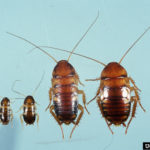 American cockroach (Periplaneta americana) Nymphs  Adult |
| Australian cockroach, Periplaneta australasiae | Australian cockroaches, also known as shad roaches, are slightly smaller than American cockroaches and are reddish-brown to dark brown with yellow markings on the top of their head and the front edge of each wing. The wings extend over the insect’s abdomen, and this cockroach is about 1-¼ to 1-½ inches long. | Greenhouses are one of the more common inside locations, along with sinks, toilets and other dark, humid and warm areas. Outdoors, Australian cockroaches prefer to live under tree bark, in piles of firewood and other locations that are moist and sheltered. They feed primarily on plant material, but inside the home will feed on starchy materials. |
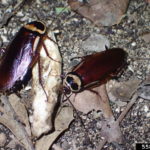 Adult Australian cockroach (Periplaneta australasiae) |
| Oriental cockroach, Blatta orientalis | Adults are dark brown to shiny black. Males are about 1 inch long. Females are about 1 1/4 inches long. The head shield (pronotum) is black and shiny. The wings of the male cover two-thirds of the abdomen. The wings of the female are reduced to small pads. Early nymphs are shiny reddish-brown. Later stages are dark reddish-brown to black. The egg case is reddish-brown to black and about 3/8 inch long. It is 1 1/2 times as long as wide. There usually are eight eggs per side. | They prefer cooler temperatures than other cockroaches. They like damp, cool areas (68-84 degrees F) — wall and porch voids, sewers, drains, basements, around pipes, in crawl spaces, under stones and in leaf litter. |
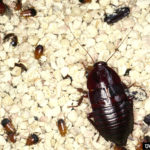 Oriental cockroach (Blatta orientalis) Multiple Life Stages |
| Smokybrown cockroach, Periplaneta fuliginosa | Adults are mahogany brown, uniform in color and shiny. They are 1 to 1 1/2 inches long. The wings cover the abdomen. Early nymphs are dark brown to black with a pale white stripe on the thorax. Later stages are reddish-brown and have darker margins. The egg cases are dark brown to black and about 3/8 inch long. Its length is more than twice its width. There are 10-14 eggs per side. | They primarily are an outdoor species and are common in the South. They lose moisture more easily than other cockroaches. They favor warm, humid areas that are not exposed to air currents. They are found in mulch, tree holes, sewers,eaves/soffits, attics and voids in walls and under sidewalks and concrete pads where there is a moisture buildup. They usually enter buildings at night through cracks and are attracted to light. |
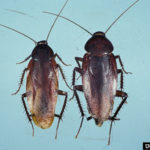 Smokybrown cockroach (Periplaneta fuliginosa) Male on left; female on right. |
| Turkestan cockroach, Blatta lateralis | Adult: female, 1 inch with cream-colored markings along the edges behind the head and around the short, rounded wings; males slightly smaller with yellowish-tan wings and cream-colored stripes along the edges Females are often confused with the oriental cockroach but can be distinguished by the cream-colored markings along the edges behind the head and around the short, rounded wings. Males are often confused with the American cockroach but are smaller and have yellowish-tan wings with cream-colored stripes along the edges. | This species is usually found in water meter boxes, cracks between blocks of poured concrete, compost piles, leaf litter, and potted plants. They may occasionally be found inhabiting sewer systems. Turkestan cockroaches are relatively new to the U.S. and are often mistaken for other cockroach species. |
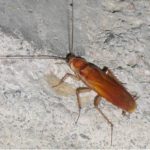 Turkestan cockroach, Blatta lateralis Male 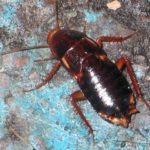 Female Blatta lateralis |
Suggested Thresholds
One cockroach justifies monitoring, and more than one justifies baiting. More than 10 justifies an inspection to find out how they are entering the structure, find areas that are not up to sanitation standards, and locate other conducive conditions. Keep in mind that each egg case may contain 14 to 24 eggs, so the threshold may vary by life stage observed.
Monitoring and Inspection
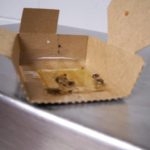 Cockroaches are primarily nocturnal and are usually active at night and hiding in harborages during the day. They are thigmotactic, preferring to harbor in locations where they have surface contact on both upper and lower body surfaces. This is why they prefer places such as the flaps of cardboard boxes and the space between wall-mounted fixtures and the wall. These are key locations for visual observation for cockroaches, egg cases, and feces. Feces may be wet or dry depending on the environment. In humid environments, these cockroaches will leave smears of fecal material. In drier environments, they will leave fecal pellets.
Cockroaches are primarily nocturnal and are usually active at night and hiding in harborages during the day. They are thigmotactic, preferring to harbor in locations where they have surface contact on both upper and lower body surfaces. This is why they prefer places such as the flaps of cardboard boxes and the space between wall-mounted fixtures and the wall. These are key locations for visual observation for cockroaches, egg cases, and feces. Feces may be wet or dry depending on the environment. In humid environments, these cockroaches will leave smears of fecal material. In drier environments, they will leave fecal pellets.
Inspection practices should include checking for unsealed openings such as missing or loose pipe and conduit escutcheons, unsealed edges around sinks and cabinets, unsealed edges of bulletin boards or wall-mounted electrical panels, mirrors, light fixtures, fire alarms, or emergency lighting. Inspections should focus on areas where food and water are present, including food storage areas, kitchens, food serving lines, cafeterias, locker rooms, concession stands, and staff lounges.
Monitoring Tips
- Monitoring stations or units should always be dated at placement so that monitoring duration is known upon station recovery.
- Place enough monitoring units to accurately monitor an area. Monitors provide valuable information about pest activity, so use a sufficient number. Food service areas should have more monitors than nonfood areas. Monitor numbers will vary according to the size of the school, number of storage and electrical closets, size of food preparation and storage areas, and other areas that are not used on a daily basis.
- If a trap is consistently empty, the trap may need to be relocated to another site. If personnel are seeing roaches and monitors are empty, the monitors are not correctly placed.
- Create a map of the area that includes the location of the traps. You may also leave space on the map to write numbers of insects per trap for each inspection. It also may be helpful to use monitor locators such as colored stickers.
- Monitors should be placed along walls or in secluded corners. Areas with pest-conducive conditions should also be monitored.
- Monitors should be kept out of view if possible. Monitors may be secured with double-sided tape.
- Monitors should be placed in clean, dry areas close to any suspected cockroach harborage.
- If possible, monitors should be placed between resources (e.g., harborage, food, water) where cockroaches may travel.
- Monitors should be replaced if full or if the monitor has been wet or is covered in dust.
- Monitors should be placed along the structural lines that roaches may travel. A misplaced trap is not as effective as one placed along structural lines.
- Monitor location is extremely critical.
Nonchemical Control Measures
The cockroaches are primarily outdoor cockroaches, so exclusion and sanitation are the primary defenses against these pests. Prompt clean up of spills, proper food storage and waste handling, preventing access to water by fixing plumbing leaks, eliminating harborage and access to the building by sealing cracks and crevices, removing products from cardboard shipping containers before shelving, and inspecting incoming products and rejecting any containing cockroaches, cockroach droppings, or egg cases can all be effective tools in preventing cockroach establishment. Clean up any areas not up to sanitation standards. Remove cardboard and other debris that could serve as shelter. Seal sinks and cracks to remove access to harborage. Ensure no gaps under exit doors.
Sanitation/Cultural Control Measures
- Eliminate clutter. Clutter creates harborage for pests. Harborage allows pests to eat, rest, and reproduce in the privacy and darkness of their own pesticide-free zone. Clutter makes it harder to clean.
- Eliminate food and water sources that can compete with bait applications
- Remove food products and food service supplies from cardboard containers as soon as they are delivered and put cardboard in outdoor recycling containers to avoid introducing cockroaches and egg cases.
- Clean up food and drink spills immediately
- Keep water in drains to keep filth and debris down.
Physical/Mechanical Control Measures
- Wipe surfaces with soapy water followed by a water rinse. The soapy water and rinse helps to remove cockroach allergens and aggregation pheromones left by cockroaches to attract other cockroaches to an area.
- Fix plumbing leaks, gutters that hold water and damp wood to eliminate access to water.
- Place exterior trash cans and dumpsters away from building entrances.
- Use liners for waste containers and empty at the end of the day so that food and food waste is not left in the building overnight.
- Position exterior lighting to avoid attracting cockroaches to building entryways at night.
- Use sodium vapor or yellow bulbs for exterior lighting to reduce attraction to cockroaches.
- Clean drains, cracks
Chemical Control Measures
Insecticide bait formulations have been developed that are effective on cockroaches. Chemical management options that reduce potential for exposure include insecticide baits in premanufactured, enclosed bait stations or gel or liquid baits placed in cracks and crevices. Bait stations may be used in areas not accessible to children. Use other bait formulations in inaccessible areas where cockroaches may hide.
Use boric acid and silica gel in dry inaccessible voids, cracks, and crevices. Be careful when applying dusts as they may move with air intake or air movement from motors.
Spray-applied residual insecticides can be used around known harborage areas, preferably outdoors or in areas away from human occupancy. Use these pesticides with care around areas where children have access. They should be used only as needed and only in targeted areas.
Always read and follow the label on the pesticide container. The label is the law. Pesticides must be used in accordance with federal, state, and local regulations. Applicators must have proper credentialing to apply pesticides and should always wear all personal protective equipment (PPE) that is specified on the pesticide label. All labels and Safety Data Sheets (SDS) for the pesticide products authorized for use in the IPM program should be maintained on file. Check with your school district for notification and posting policies.
Evaluation Methods
After the initial monitoring to pinpoint sites of infestation, treatment efforts should be concentrated at these locations. A week or two after treatment, monitors should again be placed at the infestation sites to see how well the treatment efforts are working. Place fresh traps at the locations indicated on your map and count the number of cockroaches in the traps after 24 hours. If the trap catch has dropped considerably, the cockroach population has declined and progress has been made. If not, another treatment strategy should be considered and greater efforts must be made to eliminate food, water, and harborage resources. To assess the continued success of treatments and detect any new infestations, continue to monitor after the IPM program is underway. Vigilance is important and good record keeping will save time and energy.
Compiled from publications by Godfrey Nalyanya, Lawrence “Fudd” Graham, Janet Hurley, S. Darr, T. Drlik, H. Olkowski, and W. Olkowski
